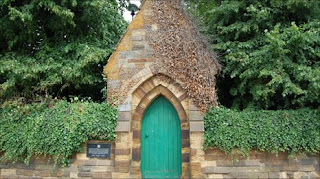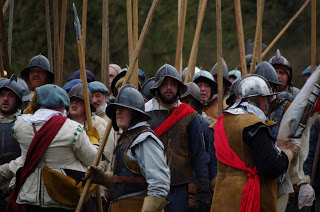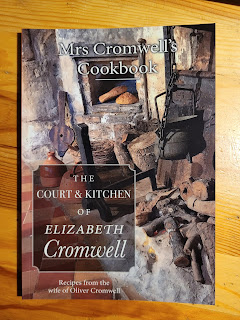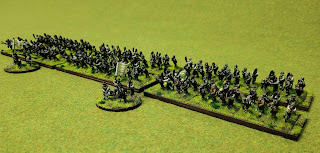Earl of Northampton’s Regiment of Horse
The Earl of Northampton's Regiment of Horse had a number of troops - detachments garrisoned Banbury, whilst the large part of the Regiment fought with the King's Oxford Army.
Originally led by the Second Earl, command would pass to his son (along with the title) after Hopton Heath.
The Regiment has an extensive roll of battle honours: Kineton Heath, Banbury, Powick Bridge, Lichfield, Stafford, Hopton Heath, Lichfield (again), Towcester, First Newbury, Leicester, Tipton Green, Cropredy Bridge, Lostwithiel, Donnington Castle, Warwick, Naseby, Rowton Heath, Langar, Stow on the Wold, before surrendering at the Siege of Banbury.
Just the one headswap here, and you may notice a hat wearing mounted casualty.
Originally led by the Second Earl, command would pass to his son (along with the title) after Hopton Heath.
The Second Earl
Spencer Compton was a great friend of Charles I, then the Prince of Wales and would be one of two bearers of his ceremonial train at his coronation.
He commanded the Royalist forces against Gell's Parliamentarians at Hopton Heath; routing the Parliamentarian cavalry and capturing eight pieces of artillery. Just as victory seemed assured, his arrogance got the better of him: he found himself too far forward, isolated and surrounded, and to make matters worse his horse stumbled, having fallen foul of a rabbit hole. Parliamentarian soldiers offered him quarter, but he refused to accept quarter from "base rogues and rebels". And so he was killed by a blow to the head from a halberd.
Night fell and both sides withdrew to regroup. Sir John Gell took Northampton's body, attempting to exchange the body for the captured ordinance. Northampton's eldest son, James (who had been wounded in the battle), now the new Earl, refused to pay what he believed to be a ransom demand.
There are now two differing stories about what happened to Spencer's body: the commonly believed story is that Gell paid to have the body embalmed and paraded it through the streets of Derby (on hearing that his demand for the return of the ordinance and the cost of embalming would not be met), where the jeering crowd desecrated the corpse. Gell had the body buried in Derby; it being returned to the family church after the Restoration.
The alternative version of events is somewhat different, and I think slightly more realistic. Hyde, writing in Clarendon’s History of the The Great Rebellion (Oxford University Press, 1967) states that Parliament allowed the Compton family surgeon to eviscerate and embalm the Earl's body; the viscera being taken to Banbury for safe keeping. Gell kept the body, parading it through Derby (the damage reported being that caused by evisceration), and had it buried in Derby at All Hallows Church (which has since been promoted to be Derby Cathedral).
Compton family history believes the body to be in the Cavendish vault alongside the Countess of Shrewsbury in Derby. The viscera being entombed in the family crypt at Compton Wynyates. Archaeological investigations do seem to support this train of events as two unlabelled sealed drums were found in the Cavendish vaults (one of which is believed to contain the Earl's body) in 1994; a slightly more recent excavation (1998, published online 2015) in the Compton family crypt found an unlabelled viscera container from the seventeenth century, and no evidence of Spencer Compton's coffin. Nothing definitive, but certainly has potential to support the less commonly held version of events.
The Third Earl
James had a number of brothers, one of whom, William, was one of the original six members of The Sealed Knot (the secret Royalist society, not the re-enactment group).
James was noted for his valour fighting at First Newbury and Cropredy Bridge; he would go on to be Constable of the Tower of London after the Restoration.
His second son, Spencer Compton first Earl of Wilmington, would become Britain's second Prime Minister.
The Regiment has an extensive roll of battle honours: Kineton Heath, Banbury, Powick Bridge, Lichfield, Stafford, Hopton Heath, Lichfield (again), Towcester, First Newbury, Leicester, Tipton Green, Cropredy Bridge, Lostwithiel, Donnington Castle, Warwick, Naseby, Rowton Heath, Langar, Stow on the Wold, before surrendering at the Siege of Banbury.
Just the one headswap here, and you may notice a hat wearing mounted casualty.
If you enjoyed reading this, or any of the other posts, please consider supporting the blog.
Thanks.












Excellent stuff. A rich roll of honour.
ReplyDeleteNot sure I’d want to be there if that viscera container were opened.
Re-reading the archaeological report, it appears that they took DNA samples from the viscera container. Can't find any published results though.
DeleteI also noticed that the crypt excavation took place in 1998, being published online in 2015. I've amended the text accordingly.
It's interesting to note how little tradition had changed between this and the Ancient Egyptians... it seems to have been a not uncommon practice...
DeleteLovely horse by the way, and yes, I did order the Cuirassiers thanks to your last post.. :o)
Thanks, and good luck with the heavy metal Steve.
DeleteThe subject of evisceration is quite an interesting wormhole to disappear down. I like the concept of French middle ages royal tradition: entrails buried where they died, heart where they were born, and body at the seat of power.
Evisceration had fallen out of practice in C17th England, which adds some weight to the 'other'story. Although there are two other contenders for occupancy of the visceral container: Countess Isabella (although her viscera are believed to be elsewhere), and that of an unknown female. Archaeologists question whether the viscera container would be buried in the same place as the body. Convention again suggesting that it belongs to the 2nd Earl.
You are just a painting machine! Awesome production these last few weeks.
ReplyDeleteActually they've been painted a wee while. In a 6 week block spanning December into January I managed 13 Regiments of Horse, 4 Foot, some pack mules and a few incidental bits.
DeleteWhereas two petard teams have been partially painted for 2 weeks and are no where near finished.